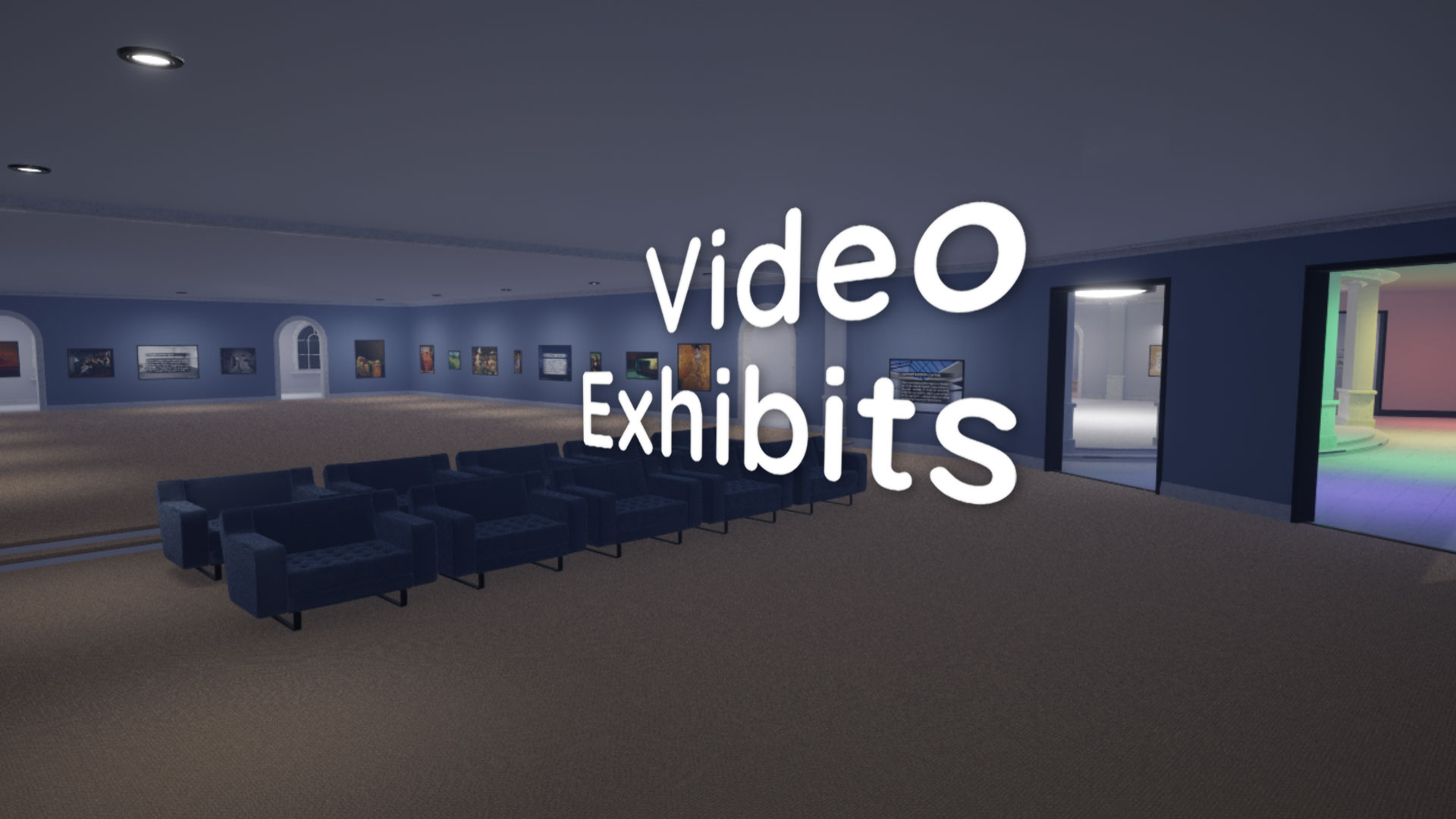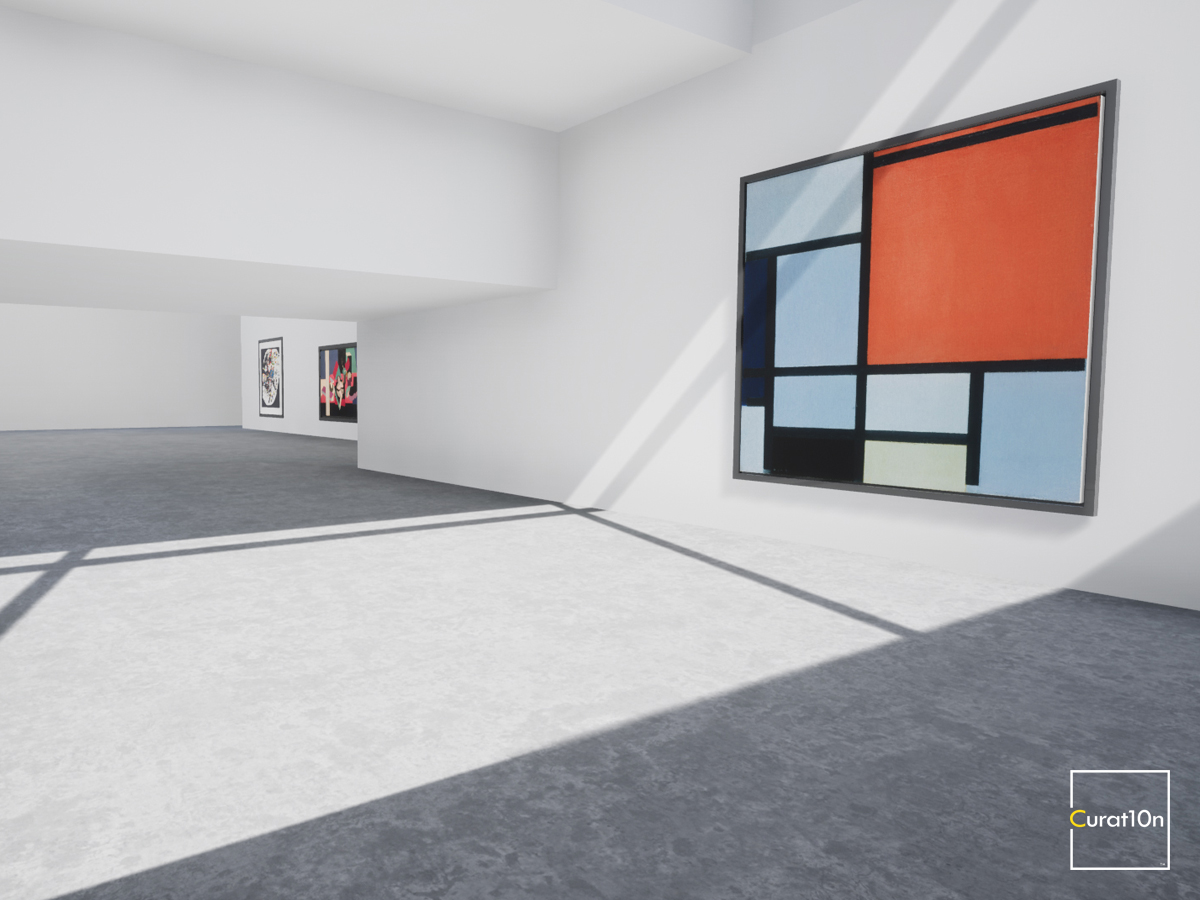Exhibition Content
You can show and share any type of multimedia content in a virtual exhibition. There are four types of exhibition content you can add to a Curation virtual exhibition. You can find out more about each of them on this page.
- Pictures: For photography, fine art, wall decals, slide shows, branding and other images.
- Video: For short films, presentations, animations, performance art, theatre and live music
- Audio: For gallery introductions, exhibition guides, artist biographies, poetry and music.
- 3D Models: For sculptures, artifacts, custom-made models and other 3D objects.
Exhibition Content Types
Pictures
Pictures are the most common type of exhibit in the majority of exhibitions. Any type of image can be added to a Curation virtual gallery.
Pictures can be displayed on any wall in a virtual gallery. They can be displayed at their real-world size, or at any scale. This means that exhibitions can show anything from small-scale framed pictures, to ceiling-high murals.
Each picture can be customized by adding a frame and changing the style of its canvas, mount and frame. There are more than 30 styles to choose from, and new styles can be created with thousands of combinations. The profile, width, depth and material of the frame can be selected. An internal border or mount of any width or material can be added. Pictures can also be shown on a basic canvas or directly on the wall.
The lighting style can also be customized for each picture, with a range of spotlights to choose from. A light fitting can be added to the wall above the picture, and these come in a range of styles and materials. Pictures can also be illuminated without having a visible light fitting in the virtual gallery.
Videos
Videos can be displayed on any wall in a virtual gallery. They can be shown on a screen, hung on the wall. Alternatively they can be projected directly onto any surface in a virtual gallery.
Each video screen can be customized by changing the style of its frame. The profile, width, depth and material of the screen can be selected Videos can also be shown on a basic canvas or projected directly onto the wall.
The lighting style can also be customized for each video exhibit, with a range of spotlights to choose from. Video screens and projectors have a gentle glow which gives them a realistic appearance and allows them to be easily seen in a darkened room, such as in real exhibition spaces.
Audio
Audio recordings can be added to a virtual gallery and presented in a number of ways. Audio exhibits such as spoken or musical performances can be attached to a picture or 3D object. When visitors interact with the picture or 3D object the audio will begin to play. Audio recordings can also be used to provide an introduction to an exhibition or gallery and these will play when visitors enter a new area.
There are several ways that audio recordings, pictures and 3D models can be combined to create exhibits.
- Add pictures or 3D models to an exhibition to signify listening points, where visitors can interact to hear an audio guide.
- Add audio recordings to pictures and other exhibits, allowing artists and curators to introduce and describe the work on show.
- 3D model can be used to signify musical exhibits. For example a set of speakers, a DJ table, or a pair of headphones can be added to the gallery. When visitors interact with these, music will play and accompany them around the exhibition.
- Create atmospheric soundscapes with spatialized audio exhibits that play in different areas of the gallery.
3D Models
3D models can be added to a virtual gallery. These could be digital versions of a real-world object, or they could be models made uniquely in 3D.
Real objects such as sculptures, artifacts and other items can be digitized. They can either be scanned to produce a 3D model, or they can be photographed from different angles before adding them to a virtual gallery.
To produce a truly 3D model, the object will need to be scanned. This can then be shown in true 3D, and can be displayed on a plinth or at any scale in a virtual space. Visitors will be able to view this from any angle and explore the object as if they were seeing it in a real gallery.
We also offer a more cost-effective and easy-to-produce option. We call this 2.5d or false-3D. This allows you to display real objects in a virtual gallery without needing to scan them: This type of exhibit uses up between 4 and 8 images taken from different angles around the object. These photographs are used to give the illusion of a 3D model as visitors walk around the virtual gallery.
Each 3D model (or 2.5d exhibit) can be shown on a plinth, table or other type of display. The style, size and material o the plinth or display can be edited. The lighting style can also be customized for each 3D exhibit, with a range of spotlights to choose from.
Exhibit Information
Every exhibit in a virtual gallery can display further information for your audience to explore. For example, you can add useful facts about each exhibit, such as text information, images, audio guides and further reading. Exhibits can also connect your audience to an online store, social media page, or any other web link.
Your audience will be able to interact with any exhibit on display and find out more about it. They can also connect with other online sources and take their experience beyond the virtual gallery. Some other examples might include an online guest/comment book, a message forum, video conferencing, social media pages, or an online store.
Types of information you may want to include: Title, Artist/Creator, Date, Medium, Price, Description, Credit, Artist Image, Provenance Documents, Web Link, Comment Book Link, Social Media Link, Contact Link…etc.
Curation Exhibitions App
Download the latest version of the Curation Exhibitions platform for PC or Mac. Alternatively, you can start exploring Curation Exhibitions now by streaming it online.
Exhibition Design FAQs
Go to the Exhibition Design FAQ page if you have questions about gallery management, curating and how you can add pictures, video, audio and 3D models to your virtual gallery.
Start Designing your Own Virtual Exhibition
- Get started by filling in the enquiry form below, or email us at contact@curation-exhibitions.com
- If you would like to use one of our ready-made galleries, tell us which space you’re interested in and we can start setting things up.
- If you want to recreate a real-world location you can send us a link or pictures, or tell us a little about the virtually gallery space you want like to make. We can then give you a quotation for the price.
- Contact us if you have any questions or if you woudl like to speak to us by phone or video call.
- We are happy to talk with prospective clients and to talk about new projects. There is no obligation to make a purchase. Make the most of our exhibition design expertise before you make a decision.







